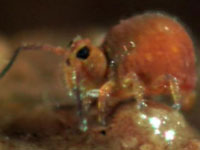Springtails |
 Springtails are insects in the order collembolan. Although they are in the insect class, being wingless having poor vision, they are more primitive than most insects. This leads some entomologists to believe they should have their own class, collembolan. A device called a furcula attached to the springtail's abdomen allows it to 'jump' three to four inches, a distance 100 times its body length of one or two millimeters. The fork-shaped furcula is normally held down flat against the insect's abdomen and when released, it propels the springtail into the air. HabitatSpringtails live in moist places all over the world. Species of springtail can live on snow, on the surface of water, and in tidal areas. Most springtails prefer soil and damp decaying places like under leaves, wood and organic debris. They feed on a variety of organic matter including rotting vegetation, bacteria, fungi, algae, lichen and insect waste. Springtails are beneficial to soil. As they eat, they break down organic matter and release nutrients back to the soil, enriching it. Spring tails are sometimes considered pests in agriculture, but are more often harmless and do not damage crops. Their presence is in fact an indication of good soil health Interaction with HumansWhen their natural habitat dries out, springtails sometimes invade human homes. Although they do not harm humans or damage homes, they can be a nuisance, especially when they come inside in great numbers. They are attracted to damp places. Any damp or molding wood attracts them, particularly inside furniture or wooden window frames. In bathrooms and showers, near drains or in moist corners, spring tails can become a problem. They sometimes are found in the soil of houseplants. Although it may be alarming to spot them, they do not typically cause damage to house plants. Their presence actually shows that the plant's soil is healthy. If the plant can tolerate it, allowing the soil to dry out will usually get rid of spring tails. ControlThe best way to keep springtails out of a home is by keeping it aired out and free of moist or moldy places. In humid climates this can be difficult. If springtails become a nuisance, the advice is to keep the air conditioner on to dry out the air or to use a dehumidifier. Removing any rotting or moldy wood that provides indoor springtail habitat is also a good idea. |
FREE QUOTE
Let's Get Started...
Save 20% By Scheduling Online...
Address
 Website Powered by BannerOS. Your Business Energized!
Website Powered by BannerOS. Your Business Energized!





